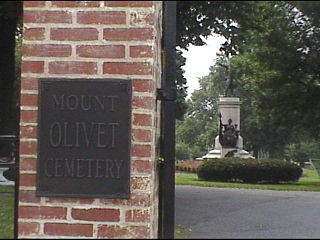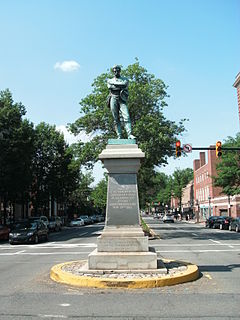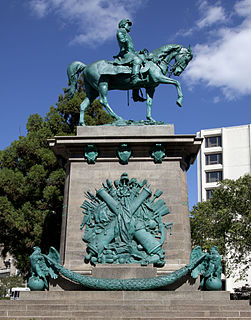
Price Park is a small city park in Keytesville, Chariton County, Missouri.

Price Park is a small city park in Keytesville, Chariton County, Missouri.
From the late nineteenth century, the city block that became Price Park was the site of the Chariton County jail. In 1906–07, a new jail was built a short distance away, and the old jail was destroyed and the property sold by the county government. [1] The park plat—circa 0.6-acre (2,400 m2)—was eventually purchased by a group of "progressive women", who conveyed it to the local chapter of the United Confederate Veterans, who in turn, in 1915, transferred title to the city of Keytesville. [2] By that time, a bandstand had been built on the property, but the area was still encumbered with tree stumps, old concrete, and other debris. [3]
In 1911 a successful campaign by Missouri state representative John D. Taylor (1883–1943), [4] acting at the behest of the local chapter of the United Daughters of the Confederacy (UDC) and other locally prominent women, resulted in a state appropriation of $5,000 to erect a monument to commemorate the Mexican–American War hero, Missouri governor, and Confederate major general Sterling Price (1809–1867), who had owned a hotel and mercantile business in Keytesville from the early 1830s. [5] The UDC contributed $11,000 toward the monument, and the state later voted an additional $2,000. [6]
In 1914 the commission for a statue of Price was awarded to the New York sculptor Allen George Newman (1875–1940), who specialized in military monuments and who had already created the iconic Spanish–American War statue The Hiker . [7] According to Newman's son, the sculptor had noted a man on a New York City street who he felt had the bearing and figure to be a general. By chance, the man had served as an aide to Price and agreed to serve as a model for the statue. [8] The statue and pedestal were fabricated by McNeel Marble Works of Marietta, Georgia, a company that eventually produced 140 Confederate statues. [9] The park was tidied up, and the statue was unveiled on June 17, 1915—without mention of the sculptor. [10]
By the late 1980s, the Price statue was clearly deteriorating, and the granite pedestal was stained. The Friends of Keytesville organized a fund-raising campaign, and the statue was restored by Washington University Technology Associates. A rededication of the statue was held on June 17, 1990, and the statue has since been maintained by the Friends of Keytesville. [11]
In 1993, a stone and plaque memorializing the Potawatomi Trail of Death, which passed through Keytesville in 1838, was dedicated in Price Park. [12] Another monument recognizes former Keytesville mayor Dred Finnell and his wife Lula Fultz Finnell, creators of an educational and community trust for Keytesville. [13]

Chariton County is a county located in the north-central portion of the U.S. state of Missouri. As of the 2010 census, the population was 7,831. Its county seat is Keytesville. The county was organized November 16, 1820, from part of Howard County and is named for the Chariton River.

Keytesville is a town in, and the county seat of, Chariton County, Missouri, United States. The population was 471 as of the 2010 census. Keytesville is the hometown of two notable American generals, Maxwell D. Taylor and Sterling Price.

Monument Avenue is a tree-lined grassy mall dividing the eastbound and westbound traffic in Richmond, Virginia, originally named for its emblematic complex of structures honoring those who fought for the Confederacy during the American Civil War. Between 1900 and 1925, Monument Avenue greatly expanded with architecturally significant houses, churches, and apartment buildings. Four of the bronze statues representing J. E. B. Stuart, Stonewall Jackson, Jefferson Davis and Matthew Fontaine Maury were removed from their memorial pedestals amidst civil unrest in July 2020. Two others still retain their bronze statues: the Robert E. Lee monument dedicated in 1890 and the Arthur Ashe monument memorializing the African American tennis champion dedicated in 1996.

Mount Olivet Cemetery is a cemetery in Frederick, Maryland. The cemetery is located at 515 South Market Street and is operated by the Mount Olivet Cemetery Company, Inc.

The Confederate Monument in Louisville is a 70-foot-tall monument formerly adjacent to and surrounded by the University of Louisville Belknap Campus in Louisville, Kentucky, United States. Relocation of the monument to Brandenburg, Kentucky, along the town's riverfront began November 2016, and was completed in mid-December. The granite and bronze structure was erected in 1895 by the Muldoon Monument Company with funds raised by the Kentucky Woman's Confederate Monument Association. The monument commemorates the sacrifice of Confederate veterans who died in the American Civil War.

Allen George Newman III was an American sculptor, best known for his statue "The Hiker".

The John Hunt Morgan Memorial in Lexington, Kentucky, is a monument created during the Jim Crow era, as a tribute to Confederate General John Hunt Morgan, who was from Lexington and is buried in Lexington Cemetery. The monument was originally situated on the Courthouse Lawn at the junction of North Upper and East Main Street, but was moved to Lexington Cemetery in 2018.

The John B. Castleman Monument, within the Cherokee Triangle of Louisville, Kentucky, was unveiled on November 8, 1913. The model, selected from a competition to which numerous sculptors contributed, was designed by R. Hinton Perry of New York. The statue was erected to honor John Breckinridge Castleman at a cost of $15,000 by popular subscription from city, state, and other commonwealths. The statue is made of bronze, and rests on a granite pedestal. It stands 15-feet high, with a base of 12×20 feet. The monument was placed on the National Register of Historic Places on July 17, 1997, as part of the Civil War Monuments of Kentucky MPS. There have been attempts to remove the statue since January 2019 due to the fact that Castleman was a Major of the Confederate army. The monument was removed on June 8, 2020, and is pending cleaning and relocation to Castleman's burial site.

The George Davis Monument is a monument to attorney and Confederate politician George Davis in Wilmington, North Carolina erected by the United Daughters of the Confederacy.

The General Beauregard Equestrian Statue, honoring P. G. T. Beauregard, was located in New Orleans, Louisiana, United States. The statue, by Alexander Doyle, one of the premier American sculptors, was officially unveiled in 1915.

Appomattox is a bronze statue commemorating soldiers from Alexandria, Virginia, who had died while fighting for the Confederacy during the American Civil War. The memorial was located in the center of the intersection of South Washington Street and Prince Street in the Old Town neighborhood of Alexandria.

Major General George B. McClellan is an equestrian statue in Washington, D.C. that honors politician and Civil War general George B. McClellan. The monument is sited on a prominent location in the Kalorama Triangle neighborhood due to efforts made by area residents. The statue was sculpted by American artist Frederick William MacMonnies, a graduate of the École des Beaux-Arts whose best known work is a statue of Nathan Hale in New York City. MacMonnies was chosen to design the statue following a lengthy competition organized by a statue commission, led by then Secretary of War William Howard Taft. The monument was dedicated in 1907, with prominent attendees at the ceremony including President Theodore Roosevelt, New York City mayor George B. McClellan, Jr., politicians, generals and thousands of military personnel.

The Confederate Memorial is a memorial in Arlington National Cemetery in Arlington County, Virginia, in the United States, that commemorates members of the armed forces of the Confederate States of America who died during the American Civil War. Authorized in March 1906, former Confederate soldier and sculptor Moses Jacob Ezekiel was commissioned by the United Daughters of the Confederacy in November 1910 to design the memorial. It was unveiled by President Woodrow Wilson on June 4, 1914.
The McNeel Marble Works of Marietta, Georgia, was founded in 1892 by Morgan Louis McNeel and his brother, R. M. McNeel. Its location near the Blue Ridge Mountains provided the firm with access to areas where marble and granite could be quarried.

The J. E. B. Stuart Monument is a partially deconstructed monument to Confederate general J. E. B. Stuart at the head of historic Monument Avenue in Richmond, Virginia, which was dedicated in 1907. Currently an empty granite pedestal, the equestrian statue of General Stuart was removed from its pedestal and placed into storage on July 7, 2020 after having stood there for 113 years. The removal was in response to nationally reported events of police brutality and a corresponding emergency declaration in Virginia.

The equestrian statue of John Brown Gordon is a monument on the grounds of the Georgia State Capitol in Atlanta, Georgia, United States. The monument, an equestrian statue, honors John Brown Gordon, a general in the Confederate States Army during the American Civil War who later become a politician in post-Reconstruction era Georgia. Designed by Solon Borglum, the statue was dedicated in 1907 to large fanfare. The statue has recently become a figure of controversy over Gordon's racist views and associations with the Confederacy, with some calling for its removal.

Confederate Defenders of Charleston is a monument in Charleston, South Carolina, United States. The monument honors Confederate soldiers from Charleston, most notably those who served at Fort Sumter during the American Civil War. Built with funds provided by a local philanthropist, the monument was designed by Hermon Atkins MacNeil and was dedicated in White Point Garden in 1932. The monument, standing 17 feet (5.2 m) tall, features two bronze statues of a sword and shield-bearing defender standing in front of a symbolic representation of the city of Charleston. In recent years, the monument has been the subject of vandalism and calls for removal as part of a larger series of removal of Confederate monuments and memorials in the United States.

The William Moultrie statue is a monumental statue in Charleston, South Carolina, United States. Located in White Point Garden, the statue was unveiled in 2007 and honors William Moultrie, a general in the American Revolutionary War.

A statue of Benjamin Harvey Hill stands inside the Georgia State Capitol in Atlanta, Georgia, United States. The monumental statue was designed by American sculptor Alexander Doyle and originally dedicated in 1886 at what is now Hardy Ivy Park. The statue was relocated to the capitol building in 1890.